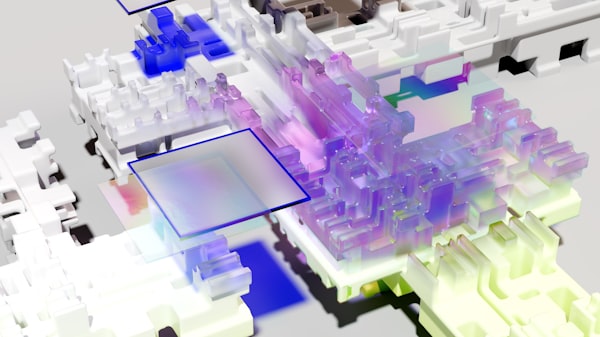Understanding SVG: An Introduction to Scalable Vector Graphics
When you first meet SVG, or Scalable Vector Graphics, it might seem a bit daunting. Like that tall, silent guy in the corner at a party who’s clearly more intellectual than you, but doesn't brag about it. You want to approach, but you're not sure where to start. Well, let me be your wingman.
SVG is an XML-based vector image format for two-dimensional graphics. In layman's terms, it's the tech-savvy chameleon of the digital design world, able to adapt and look perfect on any screen size without turning into a pixelated mess. It's like that picture of your grandmother from the '80s that's still as sharp as her wit, even when blown up to billboard size.
And here's the party trick: SVGs aren't just your typical silent and static image files. No, they're talkative! You can interact with them, animate them, and, with a bit of JavaScript love, make them dance to your tune. They’re like images that have had a few espresso shots, capable of springing into action when needed.
So, if you're dreaming of a world where your website's images are not only crystal clear but also interactive and dynamic, it's time to make friends with SVG. Trust us; it's a much easier conversation than trying to explain why you decided to start a homemade kombucha business in your garage. And remember, links to other resources are your best pals. If you want to dive deeper into the basic syntax and structure of SVGs, there's a great tutorial on MDN Web Docs, a trusted source for developers. MDN Web Docs - SVG Tutorial
Ready to make this introduction into a full-fledged friendship? Let's venture further into the world of SVG. This party is just getting started.
The Advantages of SVG in Modern Web Design
So, you've rubbed elbows with SVG, and you're wondering, "What's the big deal?" It's like when your cousin won't stop raving about her air fryer, and you're thinking, "It's just a glorified oven!" Well, my friend, much like discovering the joy of perfectly crisp french fries without the guilt of deep frying, there's plenty to love about SVG. Let's unravel the magic.
First, SVG is resolution-independent, meaning it maintains its quality on any display, from a dinosaur era desktop monitor to the sleekest, cutting-edge 8K screen. Imagine it as the "Fountain of Youth" for graphics—no matter how much you stretch it, it never loses its charm or turns pixelated.
Second, SVG is born on the web, for the web. Unlike those pesky JPGs, GIFs, and PNGs who need to be downloaded completely to be viewed, SVG loads progressively. It's like your favorite sitcom releasing an episode weekly instead of making you wait for an entire season. It's about instant gratification, folks!
Then we have the 'small file size' advantage. SVGs are code-based, so they're often lighter than their bitmap cousins. Think of it as the difference between carrying a feather (SVG) and carrying a bowling ball (other formats) up five flights of stairs. Which would you prefer?
SVG is not just your average Joe; it's versatile, too. Want some animation? SVG is on it. Fancy some interactivity? No problem for SVG. Need your graphics to respond to user actions? SVG is your guy. It's the multitasking genius we all aspire to be, with none of the burnout.
And let's not forget the SEO advantage! As SVGs are text-based, search engines can index and understand them, improving your site's accessibility. It's like that cool kid in school who everyone knows and loves. You want to hang out with that kid, right? So does Google.
Not convinced yet? There are more advantages than you can shake a stick at. Check out this comprehensive guide on Why SVG is great for SEO. Now, let's move forward to make you an SVG expert, one laugh at a time.
Getting Started with SVG: Essential Tips for Beginners
Embarking on your SVG journey is like learning to ride a bike. It seems terrifying at first. You wobble, you fall, you might even get some digital scrapes and bruises. But with a few basic techniques under your belt (and perhaps a set of metaphorical training wheels), you'll soon be cycling with the best of them.
Getting Friendly with the SVG Syntax: SVGs speak in a language of points, paths, and fills. To the uninitiated, this might look like an alien language or the cryptic text you accidentally sent your friend when your cat walked over your keyboard. Don't panic! Online resources like W3School's SVG Tutorial can help translate.
In-line or External, That is The Question: SVGs can be embedded directly into your HTML (in-line) or kept as separate files (external). If your SVG was a house, this is the choice between painting a mural on your wall or hanging a framed picture. Both have their merits and can be used interchangeably depending on your project's needs.
Learning the Lingo of SVG Animation: Animated SVGs are like digital puppet masters. They can manipulate and move graphics to create immersive and interactive experiences. However, learning to animate SVGs can feel like mastering a shadow puppet show. It's tricky, but oh-so satisfying once you get the hang of it!
Getting Crafty with SVG Editors: You don't need to be a coding wizard to create SVGs. There are user-friendly tools like Adobe Illustrator, Inkscape, and online SVG editors like Vectr that can help craft your SVG masterpiece. Think of them as your digital art studio, brimming with brushes, canvases, and easels to bring your ideas to life.
Making SVGs Accessible: Your SVGs need to play nice with everyone, including those using assistive technologies. Adding attributes like <title> and <desc> is like putting name tags on your graphics. It helps search engines and screen readers understand what they're looking at, boosting your site's accessibility.
Starting your SVG journey might feel like you're diving into a pool filled with digital spaghetti. But remember, every master was once a beginner. Grab your fork and start twirling; we're just getting started.
Mastering SVG Optimization: A Comprehensive Guide
Optimizing SVGs is like being a contestant on a digital version of "Extreme Makeover: Home Edition." Your mission, should you choose to accept it, involves transforming bloated SVGs into lean, mean, web-friendly machines, all without losing the charm that made us fall in love with them in the first place. Sounds daunting? Buckle up, because we're going in!
Trimming The Fat With Minification: Minification is the digital equivalent of getting a snazzy new haircut. It trims unnecessary whitespace, line breaks, and shortens lengthy names into compact versions. Tools like SVGO or SVGOMG do the job splendidly and are as easy to use as booking an online appointment with your barber.
Reducing the Points on Path: SVGs, much like your high school geometry teacher, love points. However, too many points can make your SVG heavier than it needs to be. Software like Adobe Illustrator allows you to simplify paths and reduce points, ensuring your SVG remains as lightweight as your Geometry teacher's sense of humor.
Removing Useless Metadata: Metadata is like the appendix of the digital world. It's often unnecessary, and getting rid of it won't hurt a bit. Most graphic editing tools store metadata like editor information, color profiles, and more, which add no value to the end-user. It's time for an appendectomy, folks!
Gzip Compression: When it comes to file compression, Gzip is the king of the jungle. Like squeezing all the air out of a storage bag, Gzip ensures your SVGs take up the least amount of space possible. Most web servers can do this automatically. So, sit back, relax, and let Gzip do the heavy lifting.
Inlining Critical SVGs: Inlining involves embedding SVGs directly into your HTML. Critical SVGs, like icons or logos that are vital to your website's first paint, should be inlined to prevent render-blocking. It's like giving these SVGs a VIP fast pass, ensuring they're seen first.
Remember, SVG optimization isn't about creating the tiniest file at all costs. It's about striking a balance between file size and quality. After all, nobody likes a pixelated logo or a graphic that takes eons to load. With these tricks up your sleeve, you're well on your way to becoming an SVG optimization ninja!
Taking SVG Animation to the Next Level: Advanced Techniques
You've dabbled in SVG animation. You've made shapes move, colors change, and paths twist and turn like a rollercoaster ride. But, like an adrenaline junkie at an amusement park, you're itching for the next big thrill. Strap in, because we're about to take SVG animation to new heights!
Harnessing the Power of SMIL: Synchronized Multimedia Integration Language (SMIL) is like SVG's in-built stunt double, ready to perform jaw-dropping animation sequences at your command. While SMIL is unfortunately not supported in all browsers (we're looking at you, Internet Explorer), it provides a high degree of control over timing, pacing, and sequencing, turning your SVG animations into well-choreographed ballet performances.
Mastering CSS Animations with SVG: If SMIL is the daring stunt double, CSS is the talented choreographer. By animating SVGs with CSS, you can take advantage of familiar syntax, browser compatibility, and integration with CSS frameworks and libraries. It's like having a universal remote for all your animation needs.
Going Beyond with JavaScript Libraries: When it comes to advanced SVG animation, JavaScript libraries like GSAP and Anime.js are like your trusted pit crew. They can animate along complex paths, sync multiple animations, and even handle user interactions, pushing the pedal to the metal on your SVG animation journey.
Creating Morphing Effects: SVG path morphing is like witnessing a digital metamorphosis. With the right manipulation of <path> elements, your SVGs can shapeshift like a master of disguise, providing a smooth, fluid visual experience that will leave your users gobsmacked.
Exploring 3D Transformations: Yes, you read that right. With SVGs, you can dip your toes into the third dimension! Although SVGs are inherently 2D, with some clever tricks, you can simulate 3D effects and add an extra layer of depth to your graphics. It's like giving your SVGs a ticket to the 3D movie of web design.
Ready to blast off into this next frontier of SVG animation? Remember, with great power comes great responsibility. Strive to create animations that are not just visually stunning, but also user-friendly and accessible. The sky's the limit!
Harnessing the Power of SVG Filters for Creativity
Ever watched a cooking show and marvelled at the sheer variety of spices and sauces they use? That's exactly what SVG filters are to your graphics: flavour enhancers. They can transform your ordinary SVGs into extraordinary visual treats. But beware, overuse can result in a visual heartburn for your users. So, let's learn to season just right!
Spicing Up with Blurs and Gradients: SVG filters such as <feGaussianBlur> and <feComponentTransfer> are like the salt and pepper of the SVG world. They add depth, create shadows, and add a delicious touch of realism to your graphics. Your SVGs will go from plain mashed potatoes to gourmet French fries in no time!
Creating Textures with Noise Filters: Adding a texture to SVGs is like giving your graphics a tactile feel. The <feTurbulence> filter is the tool for this job. It's the grated cheese on your pasta that turns it from 'meh' to 'moreish.'
Blend Modes for Visual Harmony: Blend modes like <feBlend> and <feComposite> allow SVGs to interact with each other in complex ways, creating harmonious visual compositions. Think of them as the symphony conductor, ensuring all elements play nicely together to create a visual orchestra.
Masking and Clipping for Dramatic Effects: Ever wanted to reveal an SVG like a magician pulling a rabbit out of a hat? With SVG filters for masking and clipping, you can create dramatic unveilings, hiding and revealing parts of your SVGs as per your whims. This is the cherry on top of your SVG sundae.
Displacement Maps for Advanced Effects: Using <feDisplacementMap>, you can manipulate your SVGs based on the pixel values of another image. It's like the food processor of SVG filters—feed it an image, and it will churn out mind-bending results.
But remember, while SVG filters offer a universe of creative possibilities, they can be performance-heavy. So, use them judiciously, like a master chef adding just the right amount of spices to a dish. Too little might be underwhelming, but too much could overwhelm your users' browsers and their senses. So, let's add some SVG flavor, but remember to taste as we go!
Responsive Design with SVG: Making Your Graphics Scale Effectively
Designing with SVGs can feel like being a world-famous artist painting a mural... on a shape-shifting wall. Your canvas (the viewport) can change size at any moment, thanks to the variety of devices people use to surf the web these days. But don't fret! With SVG's built-in responsiveness, you can create graphics that scale effectively, no matter the viewport.
Understanding SVG's Inherent Responsiveness: SVGs, by their very nature, are like chameleons of the digital landscape. They can scale up or down to fit their container without losing quality. It's like your SVG drank a potion from "Alice in Wonderland," growing or shrinking at will while remaining crystal clear.
Preserving Aspect Ratio with viewBox: The viewBox attribute in SVG is the unsung hero of responsive design. It's like the director of a play, deciding where the spotlight shines and how the stage is set, making sure that no matter where the audience is sitting, they have a great view.
Leveraging CSS for Responsive SVGs: SVG's natural responsiveness can be further finessed with CSS. Media queries, Flexbox, and Grid can help your SVGs sit just right in your layout, like perfectly arranging furniture in your living room to maximize space and style.
SVG Media Queries - Yes, They Exist!: While CSS media queries are common, did you know SVG has its own media queries too? This is like having a personal stylist who ensures you look your best, whether you're at a formal dinner or a casual brunch.
Adopting a Mobile-first Approach with SVG: Given the widespread use of mobile devices, designing SVG graphics with a mobile-first approach ensures your visuals look stunning even on smaller screens. It's like crafting a beautiful miniature model that can be magnified into a majestic statue, all without a hint of distortion.
Mastering responsive design with SVGs is like learning to dance with the rhythm of device diversity. It can be a tricky two-step at first, but with a little practice, you'll soon be waltzing your way to perfectly scalable and visually delightful web experiences. Ready to put on your dancing shoes? Let's twirl!
SVGs vs Other Image Formats: A Comparative Study
Picking the right image format for your web project can sometimes feel like being a contestant on a reality show. Do you go with the strong, reliable JPEG? The transparent, versatile PNG? Or the animated, fun GIF? But wait, what about our newly discovered star: the adaptable, scalable SVG? Let's pit them against each other in a friendly 'Image Format Face-Off'!
SVG vs JPEG - A Tale of Quality and Scalability: JPEGs are like your go-to comfortable pair of jeans. They're everywhere, reliable, and great for complex, detailed images. But when it comes to resizing, they falter, pixelating as they scale. SVGs, on the other hand, are like yoga pants. They can stretch and shrink without losing their sharpness, making them perfect for logos and icons.
SVG vs PNG - The Battle of Transparency: PNGs are the magicians of the image world, able to make backgrounds disappear with their support for transparency. However, they're also hefty files that can slow down your site. SVGs, like a wizard with a lighter touch, also support transparency but without the extra weight, keeping your site nimble and fast.
SVG vs GIF - The Animation Showdown: GIFs are the life of the party, bringing movement and fun to the web with their simple animations. But they're not the best quality and can be quite bulky. SVGs, like a professionally trained dancer, can perform complex animations with grace and precision, all while maintaining their light weight.
SVG vs Bitmap - Dealing with Pixels: Bitmap images, such as JPEGs, PNGs, and GIFs, are like digital mosaics made of individual pixels. When you zoom in, the illusion breaks, revealing the pixels. SVGs, in contrast, are like mathematical blueprints. They can be zoomed infinitely without losing quality, because they're not made of pixels but mathematical instructions.
While each format has its strengths and weaknesses, SVG stands out as a versatile, scalable, and lightweight option for web design. However, remember that diversity is the spice of life (and web design!). Each project might require a different mix of formats to best serve its purpose. So, keep your image toolbox varied and ready for action!
Implementing SVGs into Your Website: Best Practices
Adding SVGs to your website can sometimes feel like arranging a marriage between a prima donna and a rockstar. SVGs, with their spectacular versatility, demand attention and precision. Meanwhile, your website, the rockstar, craves speed, performance, and smooth user experience. How do we make this unlikely pair sing in harmony? Here are some best practices to get you started.
Properly Embedding SVGs: SVGs can be embedded in your HTML in a few ways - as an image source, inline code, background image, or object. Each method has its pros and cons. It's like picking the right guitar for your rockstar: the choice depends on the performance you want to deliver.
Optimize, Optimize, Optimize: As we've said before, SVGs need their 'digital make-up' before they go on stage. Tools like SVGO and SVGOMG can help strip away unnecessary metadata, optimize paths, and more, ensuring your SVGs are always ready for their close-up.
Prioritizing Accessibility: SVGs, like every other web element, should be accessible to all users. Adding descriptive <title> and <desc> tags, using ARIA attributes, and ensuring high contrast are some ways to make your SVGs inclusive. It's like tuning your guitar to make sure everyone can enjoy the melody.
Planning for Browser Compatibility: Not all browsers are created equal, and some may not fully support all SVG features. Therefore, planning for graceful degradation or providing fallbacks is essential. It's like having an emergency plan for your concert in case your rockstar falls sick.
Keep Mobile in Mind: Given the increasing mobile web traffic, ensure your SVGs render well on smaller screens too. Responsive design, touch-friendly interactive elements, and optimized animations will keep your mobile users happy. It's like making sure your concert sounds just as good on the radio as it does live.
Implementing SVGs into your website can truly enhance the user experience if done right. By following these best practices, you'll ensure your SVGs are not just visually stunning, but also fast, accessible, and enjoyable on any platform. So, are you ready to make some sweet music? Let's strum those SVGs!
The Future of SVG: Trends and Predictions
Peering into the future of SVGs feels like gazing into a digital crystal ball. As a file format that has gained significant traction in recent years, it's exciting to predict where it's headed next. Here are some trends and forecasts for the future of SVG in the swirling mists of our crystal ball:
SVGs and Interactive Storytelling: More and more designers are leveraging SVGs to create immersive, interactive storytelling experiences on the web. With their scalability and ability to be animated, SVGs are like the puppeteers of the digital storytelling world, adding life and motion to static narratives.
SVG Filters and AI: As AI becomes more pervasive, SVG filters could be used in conjunction with machine learning algorithms to create highly sophisticated visual effects and transformations. Imagine AI-powered SVG graphics that can respond and adapt to user behavior. It's like a sci-fi movie come to life!
More SVG Animation Libraries: As the popularity of SVGs grow, we predict a rise in SVG-specific animation libraries. These libraries will further streamline the process of animating SVGs, just like the proliferation of electric guitars revolutionized rock music.
SVGs in Virtual Reality (VR) and Augmented Reality (AR): SVGs' scalability and versatility make them a promising candidate for VR and AR applications. Imagine being able to manipulate SVG graphics in a 3D space, like Tony Stark in his high-tech lab!
Improved Browser Support and Standards: As SVGs continue to be a web design favorite, we anticipate better browser support and standardization. This would be like finally getting that Grammy award after years of rocking the stage!
Predicting the future is never an exact science, but given SVG's current popularity and versatility, it seems poised for continued growth and innovation. Just like our rockstar metaphorically embraced the prima donna, the web design industry appears ready to continue its love affair with SVG. So, let's keep our eyes peeled for the exciting future of SVGs!








